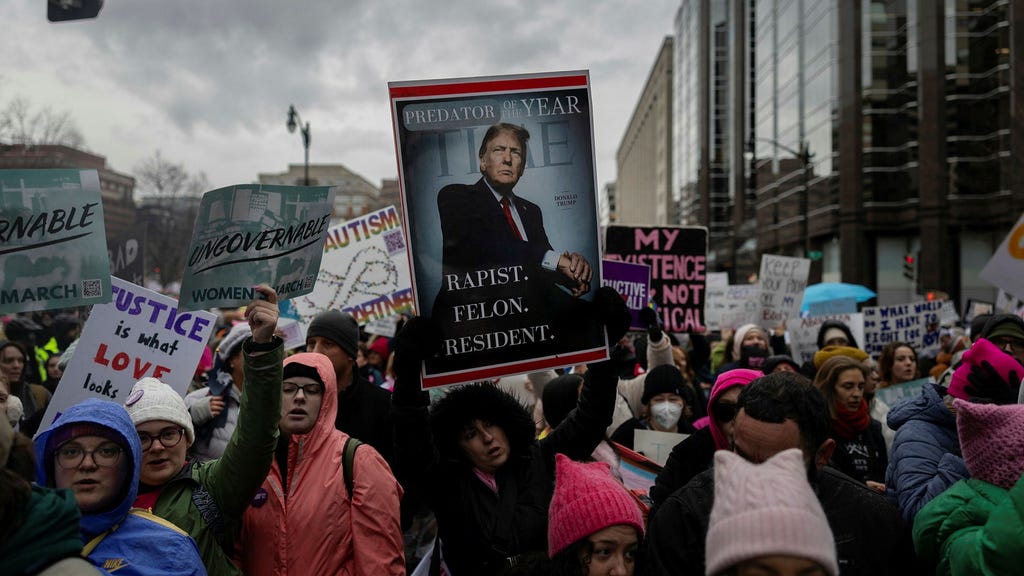A vibrant protest march, dubbed the ”People’s March,” unfolded in Washington D.C., echoing the sentiment ”Elect a clown, expect a circus,” a banner proclaimed, depicting Donald Trump with a bright red clown nose. This demonstration, occurring just days before Trump’s inauguration, served as a platform for individuals deeply concerned about the incoming administration’s policies and their potential impact on various communities. Glynis McCorkle, a veterinarian transformed into a valkyrie with large white wings, embodied the spirit of the march. Inspired by her young daughter’s love for all things bright and beautiful, McCorkle’s attire symbolized hope and resilience amidst growing anxieties. She expressed her fear for the future, particularly regarding women’s rights and reproductive freedom.
McCorkle’s anxieties resonated with many protesters who had gathered from across the country. Her personal experience, having survived sexual assault and undergone both a forced abortion and a medically necessary termination of a desired pregnancy, fueled her determination to protect women’s autonomy over their bodies. Trump’s campaign promise to leave abortion decisions to individual states did little to assuage the fears of those present. McCorkle’s story became a microcosm of the concerns shared by a broader swathe of the protesting population, highlighting the potential impact of the incoming administration’s policies on vulnerable individuals. The march provided a space for voicing these concerns and fostering a sense of collective resistance.
The march was not solely focused on women’s rights. It served as a convergence point for a diverse range of issues, from immigration policy to LGBTQ+ rights. Signs bearing slogans such as ”We will not be silent” and ”Feminists against fascists” reflected the breadth of the protesters’ concerns. Homemade signs added a raw and personal dimension to the collective message, capturing the anger and frustration felt by many towards the incoming president. The ”People’s March” represented a resurgence of activism after a period of relative quiet following Trump’s election victory, showcasing a refusal to accept the impending changes without resistance.
The marchers converged at Franklin Park, a symbolic location for the defense of women’s rights. Many wore pink ”pussyhats,” a symbol of female solidarity that had gained popularity during the women’s march against Trump eight years prior. Some even donned costumes inspired by Margaret Atwood’s dystopian novel, ”The Handmaid’s Tale,” a potent visual representation of the protesters’ fears regarding the erosion of women’s rights and bodily autonomy. The atmosphere was charged with anticipation and determination as the march commenced, with chants of ”We will not go back” echoing through the streets. The diverse costumes and signs highlighted the intersectional nature of the protest, bringing together diverse groups united by their shared concerns about the future.
From Franklin Park, the various protest groups marched towards the Lincoln Memorial, a historical site imbued with symbolic significance. It was here that Martin Luther King Jr. delivered his iconic ”I Have a Dream” speech, a powerful reminder of the ongoing struggle for civil rights. The choice of the Lincoln Memorial as the culmination point of the march connected the current protest to the historical legacy of social activism in the United States. The anticipated crowd of 50,000 individuals underscored the magnitude of the resistance to the Trump administration. This collective action served as a declaration that the protesters would not stand idly by while their rights and values were threatened.
The anxieties expressed were palpable. Constanza, an Italian protester, held a sign that read, ”How did we get here (again)?” A question that resonated with many who were struggling to comprehend the current political climate. Jake Stokke, a landscape architect, traveled from Virginia with his wife and a friend to participate in the march. He expressed his belief that Trump, who had bragged about sexually assaulting women, belonged in prison. Stokke articulated his motivation for protesting: witnessing the erosion of women’s fundamental rights and feeling compelled to use his privilege to advocate for change. The diverse backgrounds and motivations of the protesters underscored the widespread concern and resistance to the incoming administration. While acknowledging their inability to prevent Trump’s inauguration, protesters like McCorkle emphasized the importance of taking action, driven by a sense of desperation and a desire to contribute to collective resistance. The march became an act of defiance, a declaration of solidarity, and a promise to continue fighting for their values and rights in the face of adversity.














